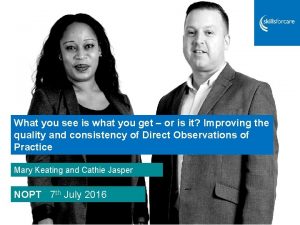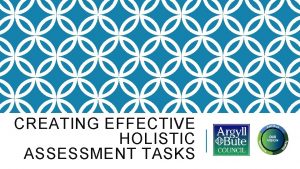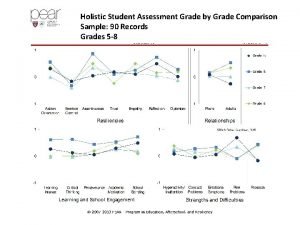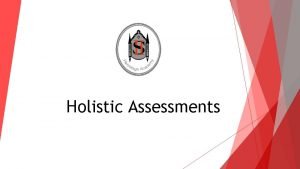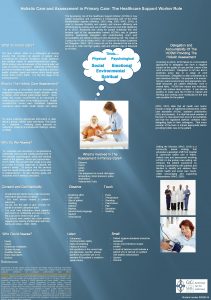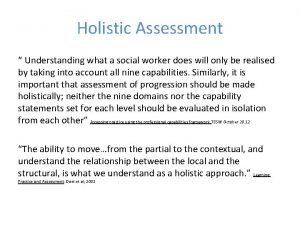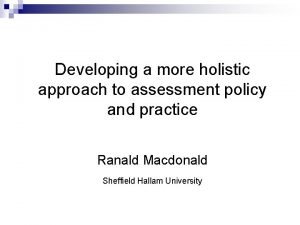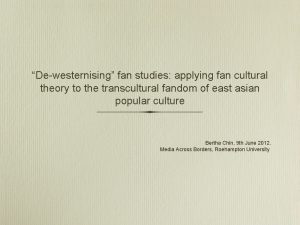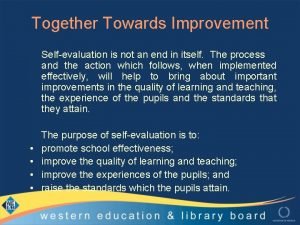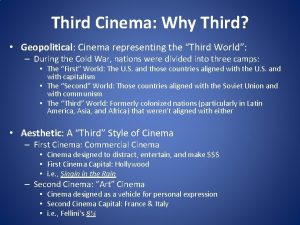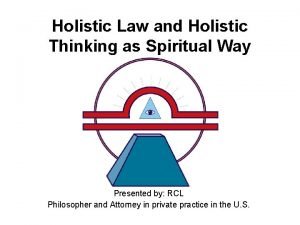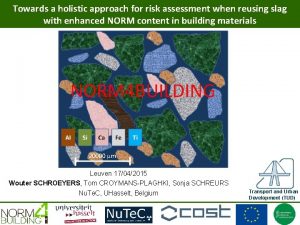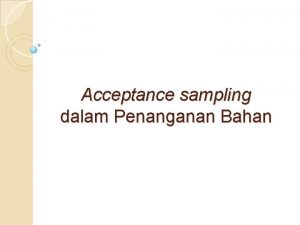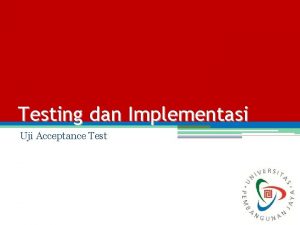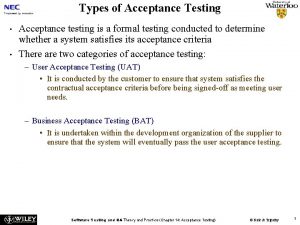Towards a holistic assessment of employees acceptance of

















- Slides: 17

Towards a holistic assessment of employees’ acceptance of innovative workplace designs Eileen Sim and Dr Christoper Heywood

Introduction/ Overview • Increasing adoption of Activity Based Working (ABW) office as an innovation • Lack of holistic evaluation method to evaluate employees’ acceptance ABW • Large-scale employees’ satisfaction surveys do not sufficiently explain why employees may be struggling to accept ABW • This study presents a holistic model for evaluating employees’ ABW acceptance that draws on the innovation adoption, technology acceptance and existing ABW literature. • First stage of research in which the model is developed from a review of the literature.

What are innovative workplaces? • Innovation as “an idea, practice or object that is perceived as new by an individual or another unit of adoption” Rogers (2003, p. 12) • Activity Based Working (ABW) – 1) Unassigned (non-territorial) individual workspaces; and – 2) A variety of workspaces designed to support a new way of working where employees switch workplaces based on their activity (switching behaviour) • ABW is a technological innovation to organisations that are introducing the ABW to their employees • Organisations are increasingly choosing ABW as the real estate intervention to achieve their Corporate Real Estate (CRE) strategies because it addresses most of the nine value-adding CRE strategies.

9 value-adding CRE strategies 1) 2) 3) 4) 5) 6) 7) 8) 9) Increase productivity; Reduce and control occupancy costs; Increase customer and employee satisfaction; Increase asset value; Increase flexibility; Increase innovation; Support image and culture; Increase sustainability; and Risk control After: Gerritse, Bergsma, & Groen, (2014); Jensen & Voordt, (2016); Lindholm & Levainen, (2006); Nourse & Roulac, (1993)

Why ABW? Cost savings Real Estate Drivers Higher space efficiency Flexibility Why ABW? Attraction and retention of talent Human Capital drivers Higher productivity Superior communication and collaboration

How are ABWs performing? Mixed outcomes about employee productivity: Increase in organisational flexibility was the only CRE strategy which outperformed the organisation’s expectations (Appel-Meulenbroek et al. , 2016; Candido, Zhang, Kim, Dear, & Thomas, 2016) (Voordt, 2004 a) (Baalen, Heck, Muelen, & Oosterhout, 2011) in (Appel-Meulenbroek, Oldman, & Susante, 2016). Issues with past office concepts are still present (Brunia et al. , 2016; Kim, Candido, Thomas, & de Dear, 2016). Struggling to accept switching behaviour (Kim et al. , 2016; Mosselman et al. , 2009; Tagliaro & Ciaramella, 2016 b); (Kim et al. , 2016; Voordt, 2004 b); (Brunia & Hartjes-Gosselink, 2009; Tagliaro & Ciaramella, 2016 b). Mixed outcomes on employee satisfaction in regards to employee interaction and support for collaboration: (Appel-Meulenbroek et al. , 2016; Been et al. , 2015; Candido et al. , 2016) ( Ekstrand, 2016) (Kim et al. , 2016). The strategy to improve the corporate image seems to be achieved (Appel-Meulenbroek et al. , 2016)

Existing methods to evaluate ABW • Large scale post-occupancy evaluation questionnaires assess employees’ agreement with subjective statements or satisfaction level • Surveys does not normally capture the ‘why’ and the behavioural responses – other methods are required • Key issue: NOT THE METHODS but what they’re capturing. • Existing measures attempt to provide proxies of employees’ acceptance. They do not specifically evaluate employees’ acceptance of the ABW features and policies. They are not holistic – employee’s affective, cognitive and behavioural responses. • Why is it important? • Employees’ acceptance of the ABW is critical. They are the endusers that the ABW is designed for and their acceptance of the workplace affects the achievement of both CRE and organisational strategies.

Research Question and Method • Research Question: • How can employees’ acceptance of innovative workplace be evaluated? • Method: • In-depth literature review and development of theoretical framework

Background theories: Employee Acceptance model • Diffusion of innovation: Success = the accumulated number of adopters over time BUT ABW diffusion is two-fold. Organisational adoption of ABW does NOT equate to employees’ adoption/ acceptance • Technology acceptance model: realising potential benefits of new technological innovations is relies on users’ acceptance (Davis, 1985). Acceptance is determined by: cognitive, affective and behavioural responses Cognitive response Affective response Behavioural response Employee Acceptance

Evaluating intended AND unintended reactions • Intended and unintended reactions to innovation are equally important but unintended reactions tend to get neglected (or are thought to be bad). • Intended reactions: The anticipated employee reactions that align with and facilitate achieving the organisation’s intended outcome and yield the potential benefits expected from the innovation. • Unintended reactions: reactions that may not align with the intended organisational outcomes which are not just negative but may also be positive.

Employee Acceptance model – Affective responses • Affect is the ‘emotional interpretation of perception, information or knowledge’. (Sailer & Penn (2010, p. 8) • Workplace relocations may cause employees to experience different affective responses such as denial, anger, bargaining and acceptance. • In the ABW literature, affective responses are rarely captured except in the joined affective and cognitive response captured by post-occupancy evaluations’ ‘employee satisfaction’. • Proposed methods 1. Forms of self-report

Employee Acceptance model – Cognitive responses • Cognition is the mental process of generating information or knowledge (Sailer, 2014). • Cognition is not solely based on incoming information but also dependent on the individual’s existing knowledge, memory, motivation, visual and spatial processing and attention. • 3 proposed and existing cognitive measures: 1. Knowledge of ABW: because employees’ behavioural responses are limited by their knowledge on how to use the innovation. 2. Perceived support for each activity conducted within the ABW. 3. Commitment to use. • The inclusion of open-ended and less structured questions enable researchers to capture unintended cognitive reactions.

Employee Acceptance model – Behavioural responses • Behaviour “… how individuals overtly act in the presence of others; actions that are observable and measurable, including verbal expression”. Includes action or inaction. • Proposed behavioural measures: 1. Extent of use observations and self-reports: 2. Territorial behavioural observations and residual markers

ABW innovation acceptance model ABW innovation acceptance Acceptance Level 1: Level 2: Limited or Non- Compliant Use Negative Affective Responses Knowledge of Low ABW Perceived support Low from the ABW Commitment of Low use Extent of Use Territorial Behaviour Low High Acceptance Level 3: Sporadic and inadequate Use Negative Acceptance Level 4: Adequate Use Neutral Acceptance Level 5: Committed and Creative Use Positive High Low High Low Moderate-High Low High Moderate More than compliant but less than committed use. Moderate-High Low-moderate High Non-existent Source: Author adapted from (Klein & Sorra, 1996) 2 possible models that provide ‘levels of innovation use’: 1) Hall & Hord’s (2015) from the education innovation field was too different 2) Klein and Sorra’s (1996) model was a multi-level unit of analysis including both organisational or collective-employee level and employee level indicators; unlike the employee acceptance model that is only for individual employee level indicators.

Next steps – operationalizing the model • Proposed methods to test the model Field work Phase Focus Group Interviews Affective outcomes Cognitive outcomes Behavioural outcomes X X X Method 4: Interview with Janitor and janitor’s photo-record X Method 5: Non-participant observation X Qualitative data • Thematic Content Analysis (Attride-Stirling, 2001) • Nvivo Quantitative data • Simple statistical analysis (eg. Mean, median, mode, percentages)

Thank you! Any questions? Contact: Dr. Chris Heywood c. heywood. @unimelb. edu. au & Eileen Sim Eileen. sim@unimelb. edu. au

© Copyright The University of Melbourne 2017
 Example of holistic assessment
Example of holistic assessment Holistic assessment example
Holistic assessment example Pear holistic student assessment
Pear holistic student assessment Holistic assessment examples
Holistic assessment examples Holistic assessments
Holistic assessments Holistic care assessment
Holistic care assessment Holistic approach social work
Holistic approach social work Holistic approach
Holistic approach Fan culture theory
Fan culture theory Deep forest: towards an alternative to deep neural networks
Deep forest: towards an alternative to deep neural networks Together towards improvement
Together towards improvement Attitude of teachers towards teaching profession
Attitude of teachers towards teaching profession What is the authors attitude
What is the authors attitude Paragraph development
Paragraph development Moving towards digitalization
Moving towards digitalization Third world
Third world His wrath towards you burns like fire figurative language
His wrath towards you burns like fire figurative language O thou who art turning thy face towards god
O thou who art turning thy face towards god
